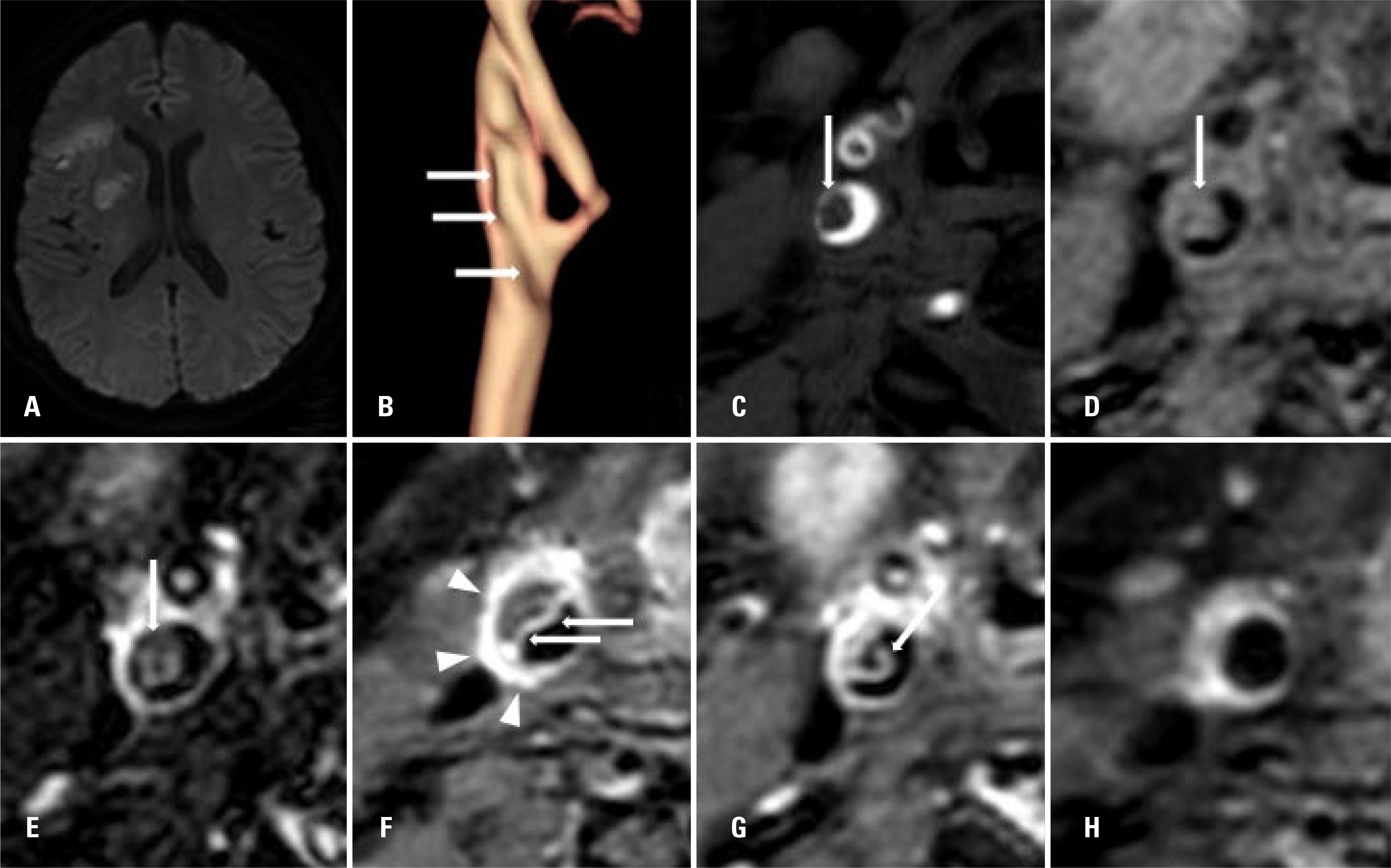Ann Clin Neurophysiol.
2017 Jan;19(1):46-49. 10.14253/acn.2017.19.1.46.
Carotidynia presenting with acute ischemic stroke after carotid sinus massage
- Affiliations
-
- 1Department of Radiology, Chonbuk National University Hospital, Chonbuk National University Medical School, Jeonju, Korea.
- 2Department of Neurology Chonbuk National University Hospital, Chonbuk National University Medical School, Jeonju, Korea. iory252@naver.com
- KMID: 2367994
- DOI: http://doi.org/10.14253/acn.2017.19.1.46
Abstract
- Carotidynia is characterized by unilateral neck pain around the carotid artery. We describe a 50-year-old woman who presented with transient left-side weakness and right-side neck pain. She frequently massaged the uncomfortable neck area during the symptomatic course of the condition. Magnetic resonance imaging revealed multifocal cerebral infarctions and a carotid intramural thrombus ipsilateral to the carotidynia.Long-term carotidynia might result in the involvement of an intramural thrombus and intimal disruption, and ischemic stroke after carotidynia may be provoked by carotid sinus massage.
Keyword
MeSH Terms
Figure
Reference
-
1.Spiller WG. Philandelphia Neurological Society: regular meeting, Jan. 28, 1927. Arch Neurol Psychiatry. 1927. 18:308.2.Upton PD., Smith JG., Charnock DR. Histologic confirmation of carotidynia. Otolaryngol Head Neck Surg. 2003. 129:443–444.
Article3.Schaumberg J., Eckert B., Michels P. Carotidynia: magnetic resonance imaging and ultrasonographic imaging of a self-limiting disease. Clin Neuroradiol. 2011. 21:91–94.4.Burton BS., Syms MJ., Petermann GW., Burgess LP. MR imaging of patients with carotidynia. AJNR Am J Neuroradiol. 2000. 21:766–769.5.Matsubara H., Takeshita K., Nakamura S., Murohara T., Miyachi S. Carotidynia with carotid arterial thrombosis. Ann Intern Med. 2012. 157:917–919.
Article6.Woo JK., Jhamb A., Heran MK., Hurley M., Graeb D. Resolution of existing intimal plaque in a patient with carotidynia. AJNR Am J Neuroradiol. 2008. 29:732–733.
Article7.Kuhn J., Harzheim A., Horz R., Bewermeyer H. MRI and ultrasonographic imaging of a patient with carotidynia. Cephalalgia. 2006. 26:483–485.
Article8.Paling D., Vilches-Moraga A., Akram Q., Atkinson O., Staniland J., Paredes-Galán E. Carotid sinus syndrome is common in very elderly patients undergoing tilt table testing and carotid sinus massage because of syncope or unexplained falls. Aging Clin Exp Res. 2011. 23:304–308.
Article9.Currò DR., Roscia G., Turri E., Dall'Ora E., Sansone S., Stockner I, et al. Acute ischemic stroke complicating carotid sinus massage in the absence of carotid artery disease and failure of thrombolytic therapy. Minerva Med. 2010. 101:193.
- Full Text Links
- Actions
-
Cited
- CITED
-
- Close
- Share
- Similar articles
-
- Carotid Sinus Syncope in an Elderly Patient With Unexplained Syncope
- Association between Carotid Artery Intima-Media Thickness and Stroke Risk Factors in Ischemic Stroke
- The Findings of Ultrasonography, CT and Magnetic Resonance Imaging of Carotidynia: A Case Report
- A Case of Carotidynia
- Surgical Treatment of Cerebral Ischemia


